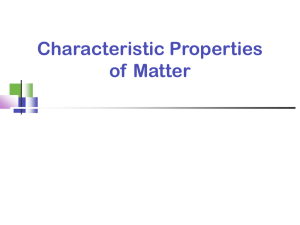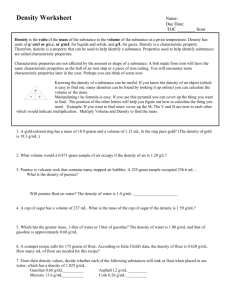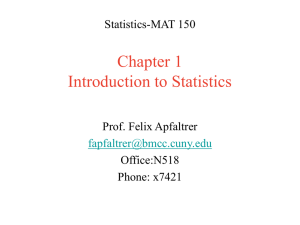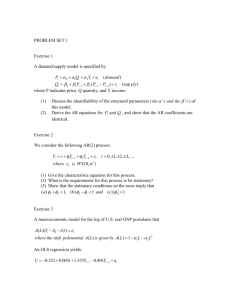Matter
advertisement
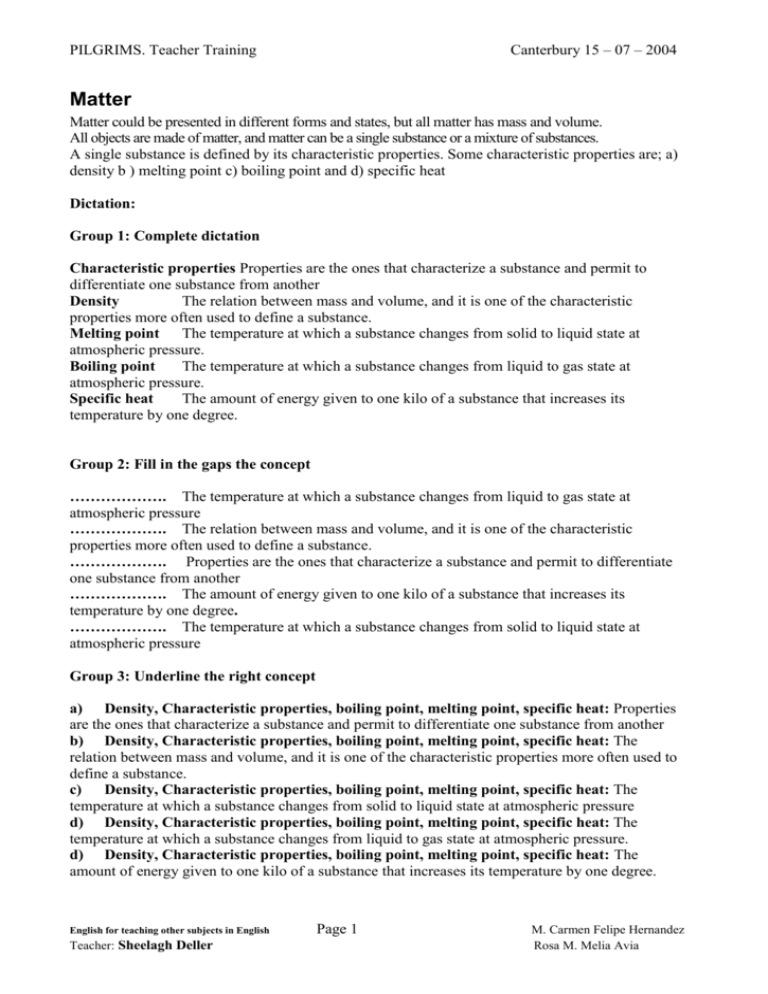
Canterbury 15 – 07 – 2004 PILGRIMS. Teacher Training Matter Matter could be presented in different forms and states, but all matter has mass and volume. All objects are made of matter, and matter can be a single substance or a mixture of substances. A single substance is defined by its characteristic properties. Some characteristic properties are; a) density b ) melting point c) boiling point and d) specific heat Dictation: Group 1: Complete dictation Characteristic properties Properties are the ones that characterize a substance and permit to differentiate one substance from another Density The relation between mass and volume, and it is one of the characteristic properties more often used to define a substance. Melting point The temperature at which a substance changes from solid to liquid state at atmospheric pressure. Boiling point The temperature at which a substance changes from liquid to gas state at atmospheric pressure. Specific heat The amount of energy given to one kilo of a substance that increases its temperature by one degree. Group 2: Fill in the gaps the concept ………………. The temperature at which a substance changes from liquid to gas state at atmospheric pressure ………………. The relation between mass and volume, and it is one of the characteristic properties more often used to define a substance. ………………. Properties are the ones that characterize a substance and permit to differentiate one substance from another ………………. The amount of energy given to one kilo of a substance that increases its temperature by one degree. ………………. The temperature at which a substance changes from solid to liquid state at atmospheric pressure Group 3: Underline the right concept a) Density, Characteristic properties, boiling point, melting point, specific heat: Properties are the ones that characterize a substance and permit to differentiate one substance from another b) Density, Characteristic properties, boiling point, melting point, specific heat: The relation between mass and volume, and it is one of the characteristic properties more often used to define a substance. c) Density, Characteristic properties, boiling point, melting point, specific heat: The temperature at which a substance changes from solid to liquid state at atmospheric pressure d) Density, Characteristic properties, boiling point, melting point, specific heat: The temperature at which a substance changes from liquid to gas state at atmospheric pressure. d) Density, Characteristic properties, boiling point, melting point, specific heat: The amount of energy given to one kilo of a substance that increases its temperature by one degree. English for teaching other subjects in English Teacher: Sheelagh Deller Page 1 M. Carmen Felipe Hernandez Rosa M. Melia Avia Canterbury 15 – 07 – 2004 PILGRIMS. Teacher Training Complete the gaps (A): Matter could be presented in different forms and states, but all matter has ……………… and ……………………… All objects are made of matter, and matter can be a single ………………… or a mixture of ………………………. A single substance is defined by its characteristic properties. Some characteristic properties are; a) ……………………., b ) ………………………, c) …………………… and d) ……………………… Write the definition of the characteristic properties: a) ………………………………. b) ………………………………. c) …………………………….... d) ……………………………... English for teaching other subjects in English Teacher: Sheelagh Deller Page 2 M. Carmen Felipe Hernandez Rosa M. Melia Avia Canterbury 15 – 07 – 2004 PILGRIMS. Teacher Training Complete the gaps (B): Matter could be presented in different forms and states, but all matter has m…………… and v……………………… All objects are made of matter, and matter can be a single s………………… or a mixture of s………………………. A single substance is defined by its characteristic properties. Some characteristic properties are; a) ……………………., b ) ………………………, c) …………………… and d) ……………………… Write the definition of the characteristic properties: a) Density b) Melting point c) Boiling point d) Specific heat English for teaching other subjects in English Teacher: Sheelagh Deller Page 3 M. Carmen Felipe Hernandez Rosa M. Melia Avia Canterbury 15 – 07 – 2004 PILGRIMS. Teacher Training Complete the gaps using (C): mass, substance, density, volume, boiling point, specific heat, substances, melting point. Matter could be presented in different forms and states, but all matter has ……………… and ……………………… All objects are made of matter, and matter can be a single ………………… or a mixture of ………………………. A single substance is defined by its characteristic properties. Some characteristic properties are; a) ……………………., b ) ………………………, c) …………………… and d) ……………………… Match each word with its definition of the characteristic properties: a) Density b) Melting point c) Boiling point d) Specific heat 1) The temperature at which a substance changes from liquid to gas state at atmospheric pressure 2) The temperature at which a substance changes from solid to liquid state at atmospheric pressure 3) The relation between mass and volume, and it is one of the characteristic properties more often used to define a substance 4) The amount of energy given to one kilo of a substance that increases its temperature by one degree. English for teaching other subjects in English Teacher: Sheelagh Deller Page 4 M. Carmen Felipe Hernandez Rosa M. Melia Avia Canterbury 15 – 07 – 2004 PILGRIMS. Teacher Training Find the words that are included in your category: Separation methods (6) filtration evaporation distillation decantation crystallization chromatography Characteristic properties (4) density boiling point specific heat melting point Heterogeneous mixtures (6) sand granite oil and water ice cream blood smoke Pure chemical substances (6) water hydrogen salt carbon dioxide butane sugar Homogeneous mixtures (6) bronze brass salt with water air rubbing alcohol carbonated water Next day recapitulation: write on the board some word with jumbled letters Filtration Density salt sand evaporation distillation decantation crystallization chromatography boiling point specific heat melting point water hydrogen carbon dioxide granite smoke bronze brass rubbing alcohol carbonated water Chemical substances and mixtures Material systems can be divided between pure chemical substances and mixtures. Pure chemical substances can be recognized because each one has its characteristic properties. Pure chemical substances are seen as uniform matter. Mixtures do not have properties that characterized them and show some of the properties of each substance that is in the mixture. Mixtures can be seen as uniform or not, and, in this case, you can see the different compounds. Differences between substances and mixtures Chemical pure substances can be formed by only one element, and sometimes called directly as elements or simple substances, or by more than one element and called compounds. Chemical Substance Mixture maintain the same proportionality of its components it takes place in a lot of different proportionalities does not have characteristic properties does not have characteristic properties has characteristic properties to separate components we need a chemical reaction English for teaching other subjects in English Teacher: Sheelagh Deller Page 5 M. Carmen Felipe Hernandez Rosa M. Melia Avia Canterbury 15 – 07 – 2004 PILGRIMS. Teacher Training Exercise: Teacher says some words, students listen only. Each student has to write only one word on the board. These words or groups of words are the answers to the questions that the teacher has in their mind. Student should guess the right question. The teacher erases the word when someone finds out the correct question. At the end, the students were asked to write another time all the words - one word each student and explain their chemical meaning. solid, liquid and gas homogeneous and heterogeneous melting point and boiling point H2O to define a pure substance to separate a heterogeneous mixture of a solid and a liquid distillation gram through millilitre mixture density English for teaching other subjects in English Teacher: Sheelagh Deller Page 6 M. Carmen Felipe Hernandez Rosa M. Melia Avia

